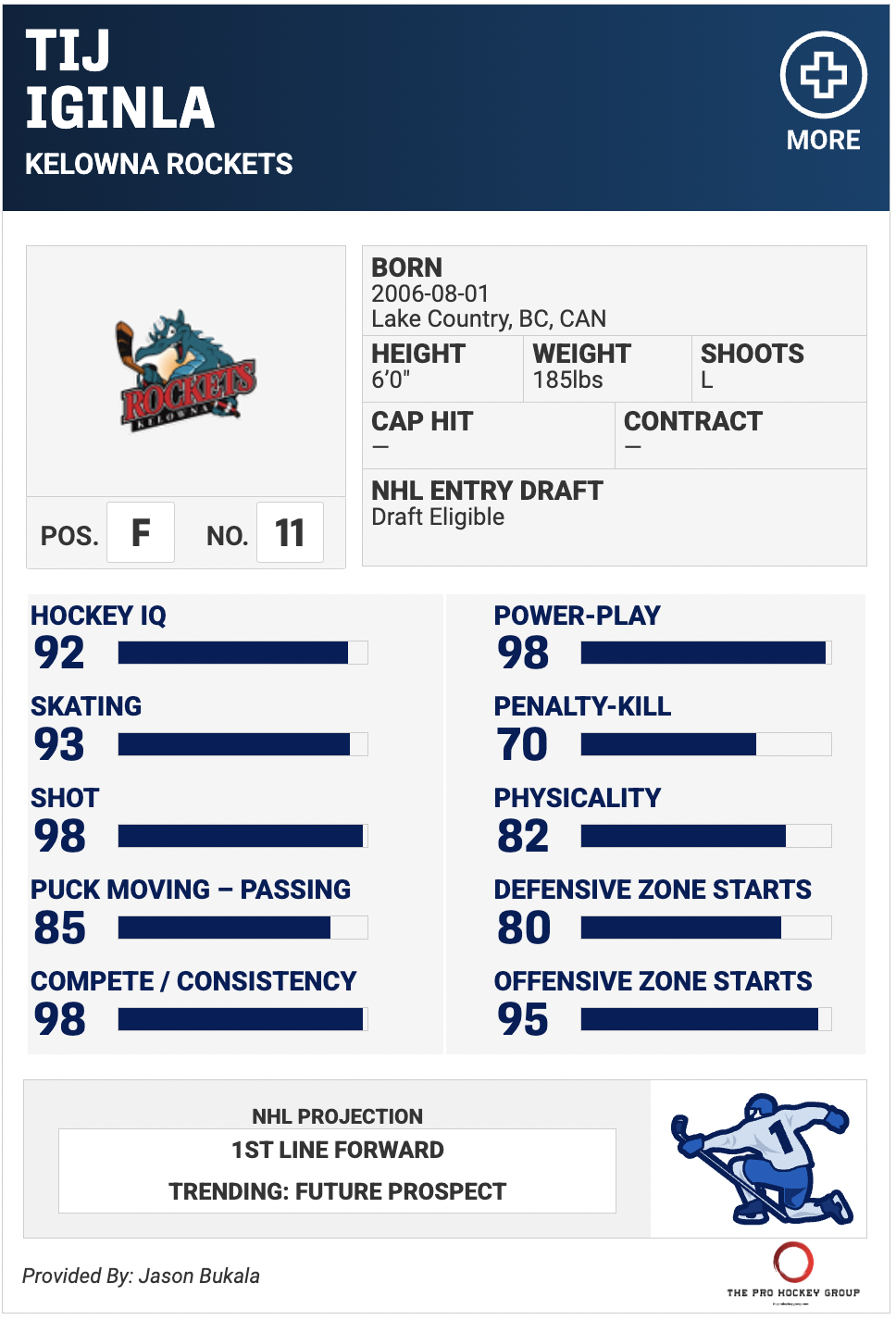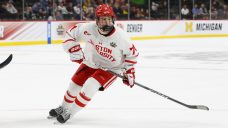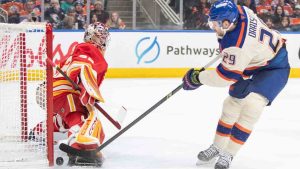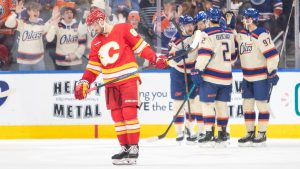Over the course of my scouting career, I have come to expect the unexpected on the draft floor.
It’s never wise to expect your team's draft list will fall neatly into place. There’s always a team, or two — (maybe three!) — that seemingly goes off the board to make a surprise selection. They might have stepped up to take a player our group valued or they reached for a prospect who was targeted later in the draft.
The process of list building is a strategic one. Each NHL team will arrive at the draft with their first-round list split into categories. I describe each category as a "line in the sand." It’s a simple process. If a prospect lands on my list above my line in the sand, I'm selecting them and not entertaining calls for the draft slot. Conversely, if my list has dried up in a section and the next set of names I value falls below my line in the sand, I will entertain trading back in the draft to select a player from the next section of my list.
The most entertaining trade occurs when a team strategizes moving up in the draft to target an asset they hold in high regard. The cost of moving up in the draft ranges. Not every draft year produces the same quality projection from the prospect pool. There are times when teams will elect to receive current draft capital, but also add extra picks to their future draft board based on the fact they feel more comfortable about the quality of future draft classes.
Something I find very interesting are the historical results of one draft slot compared to another. Here are some examples, showing the average number of games played and point production, from different draft slots between the years 2005 and 2020:
Pick No. 2: Average games played (588), average points (441)
Pick No. 5: Average games played (450), average points (229)
Pick No. 15: Average games played (181), average points (100)
Pick No. 32: Average games played (56), average points (18)
Not every draft class is made equal. There are years when players like Aleksander Barkov are selected second overall (2013, Panthers), compared to a year when a player like Alexis Lafreniere goes first overall (2020, Rangers).
Looking more closely at the 2020 draft, an argument could be made that both Tim Stutzle (third, Senators) and Lucas Raymond (fourth, Red Wings) could have switched places with Lafreniere and Quinton Byfield (second, Kings).
The reason I’m positioning all of the above is to better prepare you for some of the prospects who could be "disruptors" in the first round this year. As in, players who could get picked earlier than expected, and throw of draft rankings and how teams planned for things to go.
Here’s a look at some names that could have an impact on the flow of the first round in Las Vegas:
Ivan Demidov
Height: 5-foot-11
Weight: 181 pounds
Position: Left shot forward
Team: SKA St. Petersburg (KHL)
Season stats: 47 games played, 34 goals, 54 assists, +66
I have Demidov as the second-ranked prospect on my draft list. He has one year left on his contract with SKA St. Petersburg in Russia and Demidov has indicated he is planning on coming to North America after it expires. He’s been a difficult player to lay eyes on live this season, but Demidov has arrived in Florida to skate in front of all 32 NHL clubs at the “Gold Star Hockey Draft Camp” being hosted by his agent Dan Milstein.
Demidov projects as at top line scoring forward. Some of my European contacts believe he is inching closer to consensus No. 1 pick Macklin Celebrini in relation to his explosiveness and pure skill.
After San Jose walks to the podium to select Celebrini it will be interesting to see what Chicago does at No. 2. If they decide to go in another direction, which is entirely possible with the likes of right-shot defenceman Artyom Levshunov also available, it will have a ripple effect at the top of the board.
Here’s a clip of Demidov playing in the KHL this season. He drives play in transition, extends below the goal line while absorbing contact, walks to the middle of the ice from the half wall and directs a puck on net.
The rebound is pounced on by his teammate for the tuck, but Demidov did all the heavy lifting and used his skill in the process. It’s an example of Demidov combining his pace, skill, compete and push back to get a positive outcome.

Tij Iginla
Height: 6-foot
Weight: 185 pounds
Position: Left shot forward
Team: Kelowna (WHL)
Season stats: 64 games played, 47 goals, 37 assists
I’ve slotted Iginla fifth on my list. If Montreal elects to keep their pick it’s reasonable to assume they will draft the top available forward based on the fact they have so much organizational depth on their blue line.
I believe the Habs will be debating which forward they value the most in the top 16 of the draft. They could be staring at Iginla, hulking forward Cayden Lindstrom or elite offensive talent Berkly Catton. If I was running Montreal’s table I would make the pick, but I also would answer the phone if, say Calgary, called to offer me a swap of picks that might look like this:
To Montreal: 2024 first-round pick (ninth overall), 2024 first-round pick (28th overall)
To Calgary: 2024 first-round pick (fifth overall), 2024 second-round pick (57th overall)
Montreal would end up with picks nine, 26 and 28 in the first round and there’s a very good chance Catton will still be available at No. 9. They already owned the 26th pick, acquired in the Sean Monahan deal with Winnipeg, and with this kind of trade would add another pick in the first.
There are some intriguing names hovering around the end of the first round. I personally have a ton of time for uber-competitive forward Teddy Stiga from the USNTDP. He would add a layer of tenacious work ethic and skill to Montreal’s prospect pool. Acquiring the 28th pick from Calgary would allow Montreal the flexibility to add a player like Stiga.
Calgary would select Iginla at five, but sacrifice the 28th overall to move up (although they would add slot 57 in the second round which gives them another swing at a solid prospect).
Is this transaction likely to happen? Probably not, but these are the kinds of discussions that are taking place in the lead-up to the draft.

Cole Eiserman
Height: Five-foot-11
Weight: 197 pounds
Position: Left shot forward
Team: U.S. National Team Development Program
Season stats: 57 games played, 58 goals, 31 assists
U18 Worlds stats: 7 games played, 9 goals, 2 assists
Eiserman is the top shooter in the draft. There’s no denying he can rip pucks from pretty much all angles in the offensive zone to score goals. By now, everyone recognizes Eiserman has a lot of work to do off the puck and defensively with his effort and detail. The fact of the matter, however, is teams overpay for goal scoring in trades and free agency at the NHL level. I have Eiserman ranked 15th, but if he sneaks into the top 10 of the draft, he will definitely reset the look of the first-round for most teams.
Here's an example of Eiserman one-timing a puck on the power play. Team USA runs a set play with the four-on-three man advantage. Eiserman plays catch at the top of the zone, Team USA works a bit of a "switch and pick" between the hash marks and Eiserman finishes:

Stian Solberg
Height: 6-foot-1
Weight: 201 pounds
Position: Left shot defenceman
Team: Valerenga (Norway Elite League)
Season stats: 42 games played, 5 goals, 10 assists, +2
Playoff stats: 17 games played, 2 goals, 7 assists, -3
Solberg has already played three seasons in Norway’s top pro league and competed internationally at the world juniors and Men’s World Championships. He’s logged a ton of responsibility in high leverage scenarios at a young age.
Stolberg brings a combination of size, skill and will. His stats don’t jump off the page offensively, but he’s scratching the surface of another level of production. He’s a capable puck mover who defends with purpose. I believe he projects as a second pairing, two-way NHL defenceman and I have him ranked No. 23. Having said that, it wouldn’t surprise me in the least to see Solberg selected inside the top 20. If that did occur it would certainly have a ripple effect on some lists in the first round.
Trevor Connelly
Height: 6-foot
Weight: 160 pounds
Position: Left shot forward
Team: Tri-City Storm (USHL)
Season stats: 52 games played, 31 goals, 47 assists, +1
U18 Worlds stats: 18 games played, 15 goals, 15 assists, +7
I’m not comfortable going into too much detail about some of Connelly’s off-ice issues, but they have definitely impacted his draft stock. I spoke with several colleagues at the combine in Buffalo and some teams continue to debate whether or not to keep Connelly on their list at all.
If Connelly’s off-ice concerns didn’t exist he could be valued in the top 12 for some teams. There’s no doubt he’s an elusive offensive talent. He’s always in motion and difficult to contain. Connelly has some warts defensively, but it’s a choice and mindset to defend with purpose and something a coach can drag out of a prospect in time. I’m keenly interested to see which team decides to select Connelly and trust his process of taking responsibility for himself moving forward.
In my opinion this draft class has been building value as the season wore down. The depth of the group had momentum at the end of the season.
Having said that, this isn’t the draft to have a plethora of extra picks in.
I would have a difficult time finding enough value to use all 13 of our picks if I was at the Utah table. I would be looking to trade out some of our capital in either a hockey trade for a current NHL roster player, free agent rights, or picks in a future draft.






